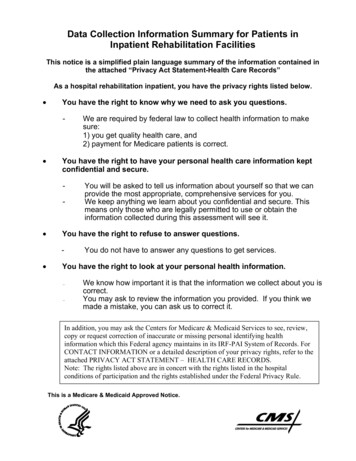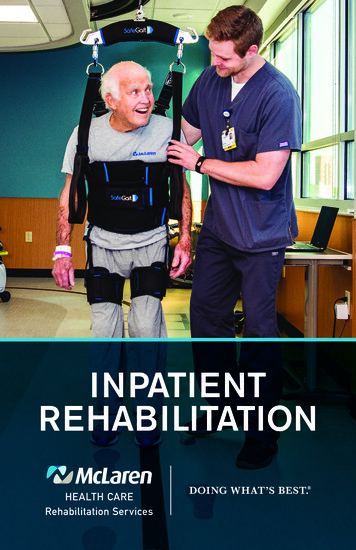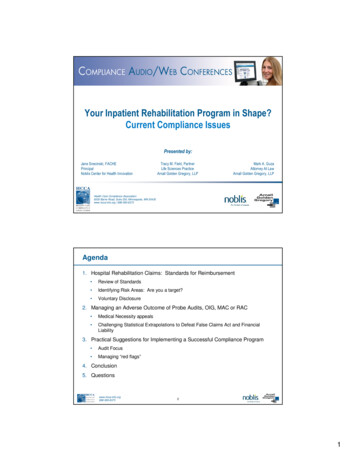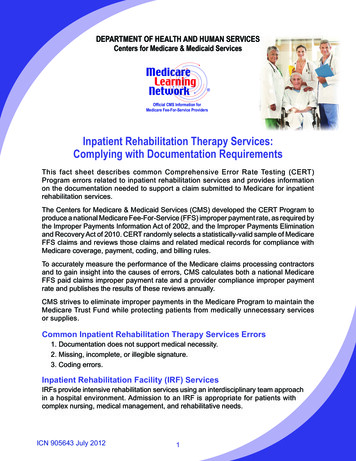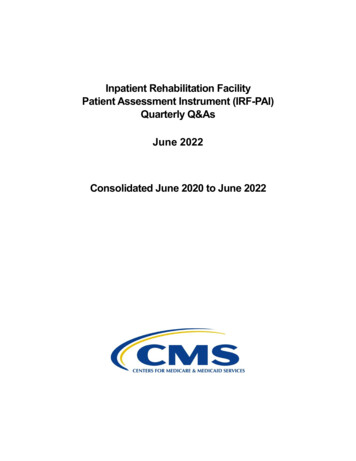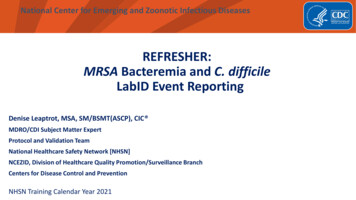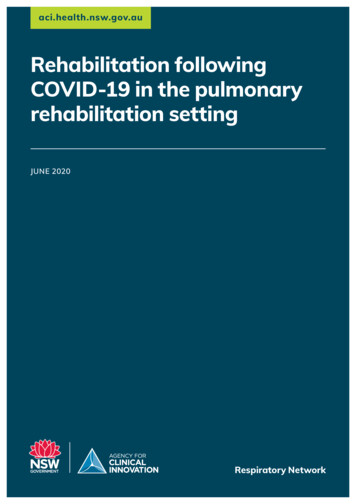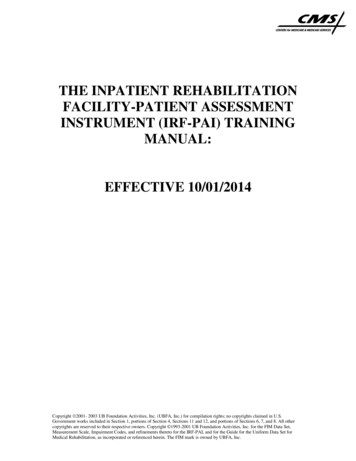
Transcription
THE INPATIENT REHABILITATIONFACILITY-PATIENT ASSESSMENTINSTRUMENT (IRF-PAI) TRAININGMANUAL:EFFECTIVE 10/01/2014Copyright 2001- 2003 UB Foundation Activities, Inc. (UBFA, Inc.) for compilation rights; no copyrights claimed in U.S.Government works included in Section 1, portions of Section 4, Sections 11 and 12, and portions of Sections 6, 7, and 8. All othercopyrights are reserved to their respective owners. Copyright 1993-2001 UB Foundation Activities, Inc. for the FIM Data Set,Measurement Scale, Impairment Codes, and refinements thereto for the IRF-PAI, and for the Guide for the Uniform Data Set forMedical Rehabilitation, as incorporated or referenced herein. The FIM mark is owned by UBFA, Inc.
TABLE OF CONTENTSHelpful Resources InformationSection 1: Introduction and Background InformationSection 2: Item-by-Item IRF- PAI Coding Instructions Item CompletionAssessment, Encoding and Data Transmission SchedulesIdentification InformationAdmission InformationPayer InformationMedical InformationFunction ModifiersFIM InstrumentDischarge InformationSignature PageSection 3: The FIM Instrument: Underlying Principles for Use of the FIMInstrument Procedures for Scoring the FIM InstrumentOverview for Use of Code 0- Activity does not occurDescription of the Levels of Function and Their Scoreso Eatingo Groomingo Bathingo Dressing- Upper Bodyo Dressing- Lower Bodyo Toiletingo Bladder Managemento Bowel Managemento Transfers: Bed, Chair, Wheelchairo Transfers: Toileto Transfers: Tub, Showero Locomotion: Walk, Wheelchairo Locomotion: Stairso Comprehensiono Expressiono Social Interactiono Problem Solvingo MemorySection 4: Quality IndicatorsSection 5: Impairment Group Codes (IGC)
TABLE OF CONTENTSSection 6: ICD-9-CM Codes Related to Specific Impairment GroupsSection 7: Comorbid ConditionsSection 8: IRF-PAI Discussion IRF-PAI Coding FormSection 9: Voluntary/Mandatory IRF-PAI Items Table 1. Non-Quality Reporting Items on IRF-PAITable 2. Quality Reporting Items on the IRF- PAISection 10: Sample Case Studies Practice Case Study #1Answers and Rational for Practice Case Study #1Practice Case Study #2Answers and Rational for Practice Case Study #2Section 11: Clarification of TerminologySection 12: CMS Data FlowSection 13: Patient Privacy and Privacy Rights Under the IRF PPS Privacy Act Statement- Health Care Records (English)Data Collection Information Summary for Patients in IRFs (English)Privacy Act Statement- Health Care Records (Spanish)Data Collection Information Summary for Patients in IRFs (Spanish)
SECTION 1: INTRODUCTION ANDBACKGROUND INFORMATIONThe purpose of this manual is to guide the user in completing the Inpatient RehabilitationFacility - Patient Assessment Instrument (IRF-PAI), which is required by the Centers forMedicare & Medicaid Services (CMS) as part of the Inpatient Rehabilitation Facility ProspectivePayment System (IRF PPS). The IRF-PAI is used to gather data to determine the payment foreach Medicare Part A fee-for-service patient admitted to an inpatient rehabilitation unit orhospital. The completion of the IRF-PAI is required for every Medicare Part A fee-for-servicepatient discharged on or after the IRF PPS implementation day of January 2, 2002. Thecompletion of the IRF-PAI is also required for every Medicare Part C (Medicare Advantage)patient discharged on or after October 1, 2009 (see the fiscal year 2010 IRF PPS final rule (74FR 39762) for more information).NOTE: This manual is a guide and revisions will be made as the IRF PPS is refined. Theserevisions may include, but are not limited to, changes resulting from research supporting the IRFPPS, legislation, regulation and refinements. Please refer to the following web site to obtain themost recent updates: yment/InpatientRehabFacPPS/index.htmlBACKGROUND Medicare statute was originally enacted in 1965 providing for payment for hospitalinpatient services based on the reasonable costs incurred in treating Medicarebeneficiaries.The statute was amended in 1982 by the Tax Equity and Fiscal Responsibility Act(TEFRA), which placed limits on deliverable costs per discharge.Social Security Amendments of 1983 established a Medicare inpatient prospectivepayment system (IPPS) for the operating costs of an inpatient hospital stay. Thefollowing hospitals and hospital units are excluded from the IPPS:o Children's Hospitalso Psychiatric Hospitalso Long-term Care Hospitalso Rehabilitation Hospitalso Distinct part Psychiatric and Rehabilitation units of IPPS hospitals and criticalaccess hospitals ; ando Cancer HospitalsTEFRA payments remained in effect for inpatient rehabilitation hospitals and distinctpart rehabilitation units from 1982 - 2001. TEFRA payments are based upon costsincurred during a base period, which resulted in inequities in payment between older andnewer facilities.The desire to control the rapid growth of rehabilitation facilities and eliminate inequitiesin Medicare payments led to Congressional action:o Balanced Budget Act (BBA) of 1997o Balanced Budget Refinement Act (BBRA) of 1999 Provisions for implementation of an Inpatient Rehabilitation FacilityProspective Payment System (IRF PPS) IRF PPS was implemented on January 1, 2002Page 1
SECTION 1: INTRODUCTION ANDBACKGROUND INFORMATION Research began on the development of an IRF PPS:o 1984: the FIM instrument was developed to address functional statusmeasuremento 1987: RAND and the Medical College of Wisconsin investigated an IRF PPS Diagnoses alone explained little of variance in cost Functional status explained more of total costs for rehabilitation patientso 1993: Functional Related Groups (FRGs) concept developed by N. Harada andcolleagues at VA Medical Center in Los Angeles as possible basis forrehabilitation prospective paymento 1994: FRGs concept refined and applied by M. Stineman and colleagues from theUniversity of Pennsylvania to large rehabilitation database for use as a patientclassification systemo 1994: RAND commissioned to study the stability of the FRGs and theirperformance related to cost rather than length of stay.o 1997: RAND finds: FRGs remained stable over time. FRGs explained 50% of patient costs and 65% of facility costs. FRGs could be used as a case mix methodology to establish an IRF PPS.o 1997: Prospective Payment Assessment Commission (ProPAC) reports toCongress: Implement IRF-PPS as soon as possible. FIM-FRGs could be an appropriate basis for the IRF PPS.o 1997: CMS published the criteria for the IRF PPS.As a result, the Secretary of Health and Human Services:o Established Case Mix Groups (CMGs) and the method to classify patients withinthese groups.o Required IRFs to submit data to establish and administer the IRF PPS.o Provided a computerized data system to group patients for payment.o Provided software for data transmission.o Recommended that the Medicare hospital claim form contain appropriate CMGcodes to support an IRF PPS.2001: CMS established a patient assessment instrument following a comparison study oftwo proposed instruments.2001: Final Rule for the IRF PPS was published.In order to be excluded from the IPPS and paid instead under the IRF PPS, an IRF isrequired to meet all applicable requirements in 42 Code of Federal Regulations 412.25and 412.29.In order for an IRF claim to be considered reasonable and necessary under section1862(a)(1) of the Social Security Act (the Act), the IRF claim must meet therequirements in 42 Code of Federal Regulations 412.622(a)(3), (4), and (5).2012: Section 3004(b) of the Affordable Care Act (ACA) directs the Secretary toestablish quality reporting requirements for Inpatient Rehabilitation Facilities (IRFs).Please see below link to text of Section 3004 of the ACA.Page 2
SECTION 1: INTRODUCTION ANDBACKGROUND INFORMATIONo Section 3004 of the ACA requires the Secretary to publish, by no later thanOctober 1, 2012, the selected quality measures that must be reported by IRFs.The ACA requires that CMS use nationally endorsed quality measures, but alsoallows CMS to specify measures that are not already endorsed if a feasible andpractical measure in the area determined appropriate by the Secretary has not beenendorsed.Page 3
SECTION 2: ITEM-BY-ITEM IRF-PAICODING INSTRUCTIONSITEM COMPLETIONAdmission and discharge IRF-PAI items must be completed before data records are transmittedto the Centers for Medicare & Medicaid Services (CMS). For a complete list of voluntary andmandatory IRF-PAI items, refer to the tables in Section 9: Voluntary/Mandatory IRF-PAI Itemsof this manual. The CMS data system will accept a record if the voluntary items are notcompleted. However, as required by Section 3004(b) of the Affordable Care Act, failure tocomplete Quality Reporting Program items may result in payment reductions of two percentagepoints starting in FY 2014. For the remaining IRF-PAI items that are identified as mandatory,any missing or invalid data entered into the data collection software may cause a record to berejected by CMS.The federal regulations require that data must be collected and entered into the data collectionsoftware (i.e., encoded) by specified time periods. An IRF may change the IRF-PAI data at anytime before transmitting the data, but only if the data were entered incorrectly.Item Completion When A Patient Has A Stay That Is Less Than 3 Calendar DaysIf the patient's stay is less than 3 calendar days in length, the staff of the rehabilitation facilitymust complete the IRF-PAI admission items, but do not have to complete all of the dischargeIRF-PAI items. However, for the discharge assessment an IRF must complete all of thefunctional modifiers and FIM instrument items. The IRF is required to collect information andrecord it on the IRF-PAI as completely as possible. Although data collection for a patient whosestay is less than 3 calendar days in length may be more difficult, particularly the dischargeassessment, codes of “0” may be used if necessary for certain function modifiers (See OverviewFor Use of Code “0” in Section 3: The FIMTM Instrument of this manual). When coding thedischarge assessment for a patient whose stay is less than 3 calendars days, it is possible that thedischarge FIM scores may be the same as the admission FIM scores. However, if a code of "0"was used on admission, then the corresponding FIM item should be scored with a "1" atdischarge. The correct date for Item 13, Admission Assessment Reference Date, is typically the3rd calendar day of the stay. If the stay is less than 3 calendar days, the admission assessmentreference date is the last day of the stay (either day 1 or day 2).EXAMPLES ILLUSTRATING THE ASSESSMENT AND DISCHARGE ASSESSMENTSCHEDULES*The following examples apply to patients whose stay is at least 3 calendar daysCharts 1 and 2 below illustrate the assessment, coding, and data transmission dates for the IRFPAI admission assessment. Charts 1 and 2 are similar to, but are updated versions of the chartsthat appear on pages 41330 and 41331 of the Final Rule entitled “Medicare Program; ProspectivePayment System for Inpatient Rehabiliation Facilities; Final Rule.” That Final Rule waspublished in the Federal Register, Volume 66, Number 152, on Tuesday August 7, 2001.Page 1
SECTION 2: ITEM-BY-ITEM IRF-PAICODING INSTRUCTIONSChart 1. - Patient Assessment Instrument Admission Assessment Schedule of DatesAssessmentTypeHospitalizationTime PeriodandObservationTime PeriodAssessmentReference DatePatientAssessmentInstrumentMust BeCompleted ByPayment TimeCovered ByThisAssessmentPatientAssessmentData Must BeEncoded ByPatientAssessmentInstrument DataMust BeTransmitted ByAdmissionAssessmentFirst 3 CalendarDaysDay 3*Day 4Entire MedicareStay TimePeriodDay 10See ** BelowFor How ToCalculate ThisDate*In accordance with section IV.A.3. of the August 7, 2001 Final Rule preamble, and the admission assessment general rule excetion as specifiedin §412.610(c)(1)(ii) CMS may stipulate instructions in this manual that may result in some items having a different admission assessmentreference date.**Because all the assessment data for admission and discharge assessments must be transmitted together after the patient is discharged, theadmission assessment data must be transmitted at the same time the discharge data are transmitted. That transmission date is by the 7th calendarday in the period beginning with the last permitted discharge patient assessment instrument "encoded by" date.Chart 2. - Example Applying the Patient Assessment Instrument Admission AssessmentSchedule of DatesAssessmentTypeHospitalizationTime PeriodandObservationTime PeriodAssessmentReference DatePatientAssessmentInstrumentMust BeCompleted ByPayment TimeCovered ByThisAssessmentPatientAssessmentData Must BeEncoded ByPatientAssessmentInstrument DataMust BeTransmitted ByAdmissionAssessment10/4/11 to10/6/1110/6/11*10/7/11Entire Medicarestay time period10/13/11See ** BelowFor How ToCalculate ThisDate*In accordance with section IV.A.3. of the August 7, 2001 Final Rule preamble, and the admission assessment general rule excetion as specifiedin §412.610(c)(1)(ii) CMS may stipulate instructions in this manual that may result in some items having a different admission assessmentreference date.**Because all the assessment data for admission and discharge assessments must be transmitted together after the patient is discharged, theadmission assessment data must be transmitted at the same time the discharge data are transmitted. That transmission date is by the 7th calendarday in the period beginning with the last permitted discharge patient assessment instrument "encoded by" date.Below, chart 3 illustrates how to determine the assessment, coding, and data transmission datesfor the IRF-PAI discharge assessment. Chart 3 is similar to, but is an updated version of a chartthat appears on page 41332 of the August 7, 2001 Final Rule and on page 45683 of the August 1,2003, Final Rule entitled “Medicare Program; Changes to the Inpatient Rehabilitation FacilityProspective Payment System and Fiscal Year 2004 Rates; Final Rule.” The August 1, 2003,Final Rule was published in the Federal Register, Volume 68, Number 148. Chart 3 illustratesthat CMS will determine that the IRF-PAI data was not transmitted late if it is transmitted nolater than 27 calendar days from the day the patient is discharged. NOTE: The discharge day iscounted as one of the 27 calendar days, and the 27 calendar day time span also includes the 10Page 2
SECTION 2: ITEM-BY-ITEM IRF-PAICODING INSTRUCTIONScalendar days specified in §412.614(d)(2). Also, the meaning of the term “discharge day,” whichis one of the days counted in the 27 calendar day time span, is the day defined according to therevised definition of “discharge” specified in §412.602 as stipulated in the August 1, 2003 FinalRule. In some cases, that may be different from the dicharge assessment reference day specificedin §412.610(c)(2)(ii).Chart 3. - Example Applying the Patient Assessment Instrument Discharge AssessmentSchedule of DatesAssessment TypeDischarge Date*AssessmentReference DatePatient AssessmentInstrument MustBe CompletedOn**Patient AssessmentInstrument DataMust Be EncodedByDate When PatientAssessmentInstrument DataTransmission 10/26/1111/12/11**** In accordance with section IV.A.3. of the August 7, 2001 Final Rule preamble, and the admission assessment general rule excetion as specifiedin §412.610(c)(1)(ii) CMS may stipulate instructions in this manual that may result in some items having a different admission assessmentreference date.**This is the last day by when the discharge patient assessment must be completed. However, this does not prohibit discharge patient assessmentdata from being recorded on the patient assessment instrument prior to this date.***Or any day after 11/12/11.NOTE: For more information regarding the admission and discharge assessments, please refer tothe IRF PPS Final Rules and other CMS publications for authoritative guidance. The CMSpublications related to the IRF PPS can be found at the CMS IRF PPS IDENTIFICATION INFORMATION1. Facility Information:A. Facility Name: Enter the full name of the facility.B. Facility Medicare Provider Number: Enter the facility medicare providernumber. Verify the number through the business office.2. Patient Medicare Number: Enter the patient’s Medicare Number (Part A). Verify thenumber through the business office.NOTE: For those patients with a Medicare Replacement plan or MedicareAdvantage Plan a Medicare number is still needed to complete this section of theIRF-PAI. For additional information regarding how to obtain this number,reference the IRF PPS FY 2010 final rule (74 FR 39799).3. Patient Medicaid Number: Enter the patient’s Medicaid Number. Verify the numberPage 3
SECTION 2: ITEM-BY-ITEM IRF-PAICODING INSTRUCTIONSthrough the business office.NOTE: This item is mandatory if the patient is a Medicaid recipient.4. Patient First Name: Enter the patient’s first name. Verify this information through thebusiness office.5A. Patient Last Name: Enter the patient’s last name. Verify this information through thebusiness office.5B. Patient Identification Number: Enter the patient’s medical record number or otherunique identifier.6. Birth Date: Enter the patient’s birthdate. The date should take the form MM/DD/YYYY,where MM is a 2-digit code for the month (e.g., 01 for January, 12 for December), DD isthe day of the month (e.g., from 01 to 31), and YYYY is the full year (e.g., 1938).7. Social Security Number: Enter the patient’s Social Security Number. Verify the numberwith the patient and/or business office.NOTE: If the patient is unwilling to disclose their social security number or if thefacility is unable to obtain this information, a blank value can be submitted withoutcausing the IRF-PAI to be rejected.8. Gender: Enter the patient’s gender as:(1- Male; 2- Female)9. Race/Ethnicity: Check all that apply.(A. American Indian or Alaska Native, B. Asian, C. Black or African American, D.Hispanic or Latino, E. Native Hawaiian or Other Pacific Islander, F. White)NOTE: If the patient is unwilling to disclose their race information or if the facilityis unable to obtain this information, a blank value can be submitted without causingthe IRF-PAI to be rejected.10. Marital Status: Enter the patient’s marital status at the time of admission.(1- Never Married; 2- Married; 3- Widowed; 4- Separated; 5- Divorced)NOTE: If the patient is unwilling to disclose their marital status or if the facility isunable to obtain this information, a blank value can be submitted without causingthe IRF-PAI to be rejected.11. Zip Code of Patient’s Pre-Hospital Residence: Enter the zip code of the patient’s prehospital residence.Page 4
SECTION 2: ITEM-BY-ITEM IRF-PAICODING INSTRUCTIONSADMISSION INFORMATION12. Admission Date: Enter the date that the patient was admitted to the IRF. The dateshould take the form MM/DD/YYYY, where MM is a 2-digit code for the month (e.g., 01for January, 12 for December), DD is the day of the month (e.g., from 01 to 31), andYYYY is the full year (e.g., 2014).13. Assessment Reference Date: This is the 3rd calendar day of the rehabilitation stay,which represents the last day of the 3-day admission assessment time period. These 3calendar days are the days during which the patient’s clinical condition should beassessed. The date should take the form MM/DD/YYYY, where MM is a 2-digit code forthe month (e.g., 01 for January, 12 for December), DD is the day of the month (e.g., from01 to 31), and YYYY is the full year (e.g., 2014). Example: If Admission Date is07/04/14, then the Assessment Reference Date is 07/06/14.NOTE: If the stay is less than 3 calendar days, the admission assessment referencedate is the last day of the stay (either day 1 or day 2).NOTE: If the patient has an program interruption, the discharge date is notincluded as one of the 3 calendar days. Example: Patient was admitted to IRF on7/4/14. Patient was discharged to Acute Care on 7/6/14. Patient returned to IRF on7/7/14. The assessment reference date would be 7/7/14. Day 1 would be 7/4/14, Day2 would be 7/5/14 and Day 3 would be 7/7/14. Example: Patient was admitted toIRF 7/4/14. Patient was discharged to Acute Care on 7/5/14. Patient returned toIRF on 7/6/14. The assessment reference date would be 7/7/14. Day 1 would be7/4/14, Day 2 would be 7/6/14 and Day 3 would be 7/7/14.14. Admission Class: Enter the admission classification of the patient, as defined below:1- Initial Rehab: This is the patient’s first admission to any inpatientrehabilitation facility for this impairment.2- THIS CODE IS NO LONGER VALID3- Readmission: This is a stay in which the patient was previously admitted toan inpatient rehabilitation facility for this impairment, but is NOT admitted to thecurrent rehabilitation program DIRECTLY from another rehabilitation program.4- Unplanned Discharge: This is a stay that lasts less than 3 calendar daysbecause of an unplanned discharge (e.g., due to a medical complication). If thepatient stays less than 3 calendar days, see the first page of Section II for itemcompletion instructions.5- Continuing Rehabilitation: This is part of a rehabilitation stay that began inanother rehabilitation program. The patient was admitted directly from anotherinpatient rehabilitation facility.15. Admit From: Enter the setting from which the patient was admitted to rehabilitation.Page 5
SECTION 2: ITEM-BY-ITEM IRF-PAICODING INSTRUCTIONS01- Home (Private home/apt., board/care, assisted living, group home,transitional living)02- Short-term General Hospital03- Skilled Nursing Facility (SNF)04- Intermediate Care06- Home under care of organized home health service organization50- Hospice (home)51- Hospice (institutional facility)61- Swing Bed62- Another Inpatient Rehabilitation Facility63- Long-Term Care Hospital (LTCH)64- Medicaid Nursing Facility (NF)65- Inpatient Psychiatric Facility66- Critical Access Hospital (CAH)99- Not ListedNOTE: Definitons of Patient Status Codes for Item 15, 16, and 44D can be foundat: SE0801.pdf16. Pre-Hospital Living Setting: Enter the setting where the patient was living prior tobeing hospitalized.01- Home (Private home/apt., board/care, assisted living, group home,transitional living)02- Short-term General Hospital03- Skilled Nursing Facility (SNF)04- Intermediate Care06- Home under care of organized home health service organization50- Hospice (home)51- Hospice (institutional facility)61- Swing Bed62- Another Inpatient Rehabilitation Facility63- Long-Term Care Hospital (LTCH)64- Medicaid Nursing Facility (NF)65- Inpatient Psychiatric Facility66- Critical Access Hospital (CAH)99- Not Listed17. Pre-Hospital Living With: Enter the relationship of any individuals who resided withthe patient prior to the patient’s hospitalization. If more than one person qualifies, enterthe first appropriate category on the list.** Complete this item only if you selected code 01 (Home) in Item 16 (PrehospitalLiving Setting).(01- Alone; 02- Family/Relative; 03- Friends; 04- Attendant; 05- Other)Page 6
SECTION 2: ITEM-BY-ITEM IRF-PAICODING INSTRUCTIONS18. DELETED19. DELETEDPAYER INFORMATION20. Payment Source: Enter the source of payment for inpatient rehabilitation services.Enter the appropriate category for both primary and secondary source of payment.(02- Medicare Fee For Service; 51- Medicare-Medicare Advantage; 99- Not Listed)A. Primary SourceB. Secondary SourceMEDICAL INFORMATION21. Impairment Group: For the admission assessment, enter the code that best describesthe primary reason for admission to the rehabilitation program (Codes for this item arelisted in the table listed Impairment Group Codes).22. Etiologic Diagnosis: Enter the ICD code(s) to indicate the etiologic problem that led tothe impairment for which the patient is receiving rehabilitation (Item 21 - ImpairmentGroup). Refer to Section 6 of this manual for ICD codes associated with specificImpairment Groups. Commonly used ICD codes are listed, but the list is not exhaustive.Consult with health information management staff and current ICD coding books forexact codes.23. Date of Onset of Impairment: Enter the onset date of the impairment that was coded inItem 21 (Impairment Group). The date should take the form MM/DD/YYYY, where MM isa 2-digit code for the month (e.g., 01 for January, 12 for December), DD is the day of themonth (e.g., from 01 to 31), and YYYY is the full year (e.g., 2014).NOTE: If a condition has an insidious onset, or if the exact onset date is unknown forany reason, follow these general guidelines: If the year and month are known, but the exact day is not, use the first day of themonth (e.g., MM/01/YYYY). If the year is known, but the exact month is not, use the first of January of thatyear (e.g., 01/01/YYYY). If the year is an approximation, use the first of January of the approximate year(e.g., 01/01/YYYY).The following represents more specific instructions for determining date of onset formajor impairment groups:Page 7
SECTION 2: ITEM-BY-ITEM IRF-PAICODING INSTRUCTIONSStroke**Date of admission to acute hospital. If this is not the patient’s first stroke, enter the date ofthe most recent stroke.Brain Dysfunction-TraumaticDate of Injury.-Non-traumaticMore recent date of: date of surgery (e.g., removal of brain tumor) or date of diagnosis.Neurological Conditions-Multiple SclerosisDate of exacerbation-All Remaining Neurological ConditionsDate of diagnosisSpinal Cord Dysfunction-TraumaticDate of injury-Non-traumaticMore recent date of: date of surgery (e.g., tumor) or date of diagnosis.AmputationDate of most recent surgeryArthritisDate of diagnosis (if arthroplasty, see impairment group “Orthopaedic Conditions”)Pain SyndromesDate of onset related to cause (e.g., fall, injury)Orthopaedic Conditions-FracturesDate of fracture- ReplacementDate of surgeryCardiac DisordersMore recent date of: Date of diagnosis (event) or date of surgery (e.g., bypass, transplant)Pulmonary Disorders-COPDDate of initial diagnosis (not exacerbation)-Pulmonary TransplantDate of surgeryPage 8
SECTION 2: ITEM-BY-ITEM IRF-PAICODING INSTRUCTIONSBurnsDate of burn(s)Congenital DeformitiesDate of birthOther Disabling ImpairmentDate of diagnosisMajor Multiple TraumaDate of traumaDevelopmental DisabilitiesDate of birthDebility**Date of acute hospital admissionMedically Complex Conditions**-InfectionsDate of admission to acute hospital-NeoplasmsDate of admission to acute hospital-NutritionDate of admission to acute hospital-CirculatoryDate of admission to acute hospital-RespiratoryDate of admission to acute hospital-Terminal CareDate of admission to acute hospital-Skin DisordersDate of admission to acute hospital-Medical/SurgicalDate of admission to acute hospital-Other Medically Complex ConditionsDate of admission to acute hospitalNOTE: If there was no admission to an acute hospital prior to the admission to theinpatient rehabilitation facility, record as the date of onset the date of diagnosis ofthe impairment which led to the admission to the rehabilitation facility.Page 9
SECTION 2: ITEM-BY-ITEM IRF-PAICODING INSTRUCTIONS24. Comorbid Conditions: Enter up to twenty-five (25) ICD codes for comorbidconditions. A patient comorbidity is defined as a secondary condition a patient may havein addition to the primary diagnosis for which the patient was admitted to the IRF. EnterICD codes which identify comorbid conditions that are not already included in theImpairment Group Code (IGC). The patient comorbidity/ies listed in Item 24 of the IRFPAI should have significant impact on the patients’ course of treatment for their primarydiagnosis. Comorbidities that are identified on the day prior to the day of therehabilitation discharge or the day of discharge should not be listed on the dischargeassessment, since these comorbidities have less effect on the resources consumed duringthe entire stay.NOTE: Providers should complete the number of spaces that coincides with thenumber of comorbid conditions the patient has. Providers do not need to completeall 25 spaces of this item, unless of course, the patient has 25 comorbid conditions.Example: The patient has 15 comorbid conditions. The provider should complete 15spaces for this item.24A. Arthritis Conditions: Enter one of the following codes to indicate whether one ormore of the arthritis conditions recorded in items #21(Impairment Group), #22(EtiologicDiagnosis), or #24(Comorbid Conditions) meet all of the applicable regulatoryrequirements for IRF classification (in 42 Code of Federal Regulations 412.29(b)(2)(x),(xi), and (xii)).(0- No; 1- Yes)If the code 1- Yes is entered into this item, then this claim may be selected by the MACfor review of the documentation in the IRF medical record to assure that the patient hasmet all of the applicable regulatory requirements, including that the patient has completedan appropriate, aggressive, and sustained course of outpatient therapy services or servicesin other less intensive rehabilitation settings immediately preceding the IRF admission.CMS expects that the IRF will obtain copies of the therapy notes from the outpatienttherapy or from the therapy services provided in other less intensive settings and includethese in the patient’s medical record at the IRF (in a section for prior records). Theseprior records will be available to the MAC staff who reviews the medical records forcompliance with the applicable regulatory requirements.NOTE: Below references 42 Code of Federal Regulations 412.29(b)(2)(x), (xi), and(xii)) for additional information about the regulatory requirements.(x) Active, polyarticular rheumatoid arthritis, psor
The purpose of this manual is to guide the user in completing the Inpatient Rehabilitation Facility - Patient Assessment Instrument (IRF-PAI), which is required by the Centers for Medicare & Medicaid Services (CMS) as part of the Inpatient Rehabilitation Facility Prospective . 2001: CMS established a patient assessment instrument .


